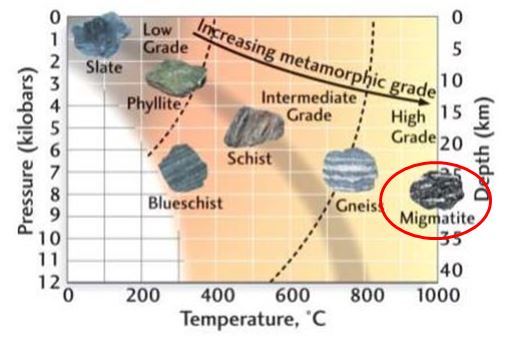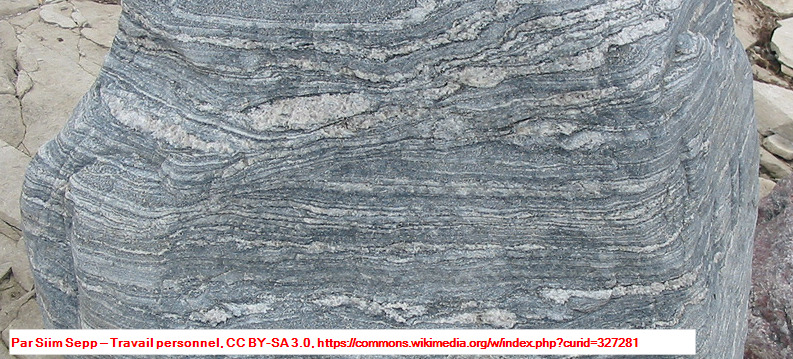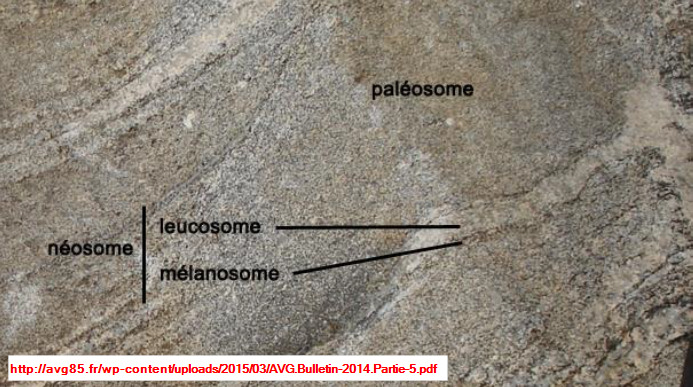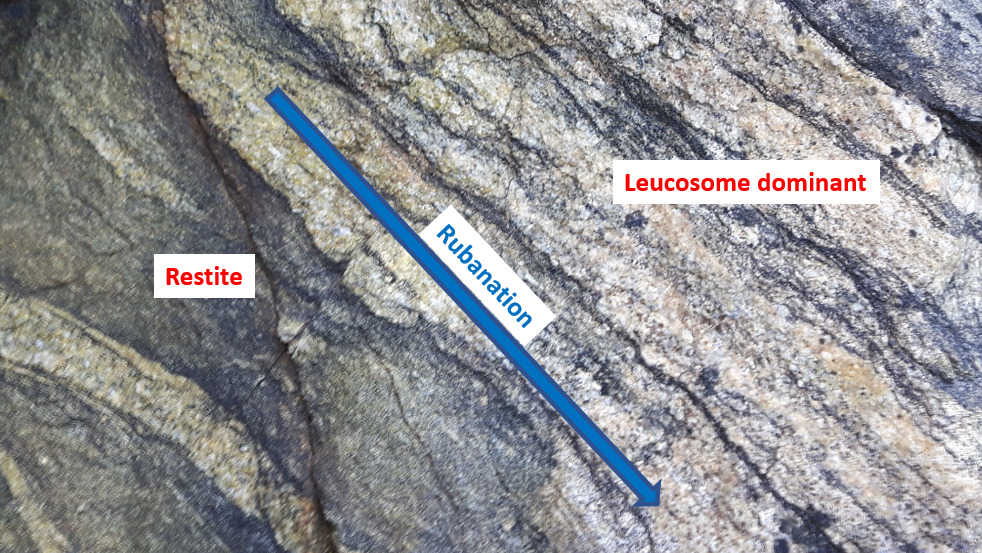
La Earthcache / The Earthcache
► Contexte géologique local
Le Pays de Léon est une antiforme présentant dans sa partie littorale une série métamorphique affleurant au Nord du Cisaillement senestre de Porspoder-Guissény (CPG), le complexe migmatitique de Plouguerneau.

Particulièrement visible à la pointe de d’An Dol Ven, ces migmatites sont issues d’une fusion partielle d’un matériel ancien, les paragneiss de Lesneven.
Partons à la découverte de ce symbole de la fusion d'une croûte continentale.
► Roche métamorphique et Migmatites
Une roche métamorphique est une roche secondaire issue de la métamorphisation (transformation sous l'effet de la pression et de la température) d'une roche primaire appelée protolithe.
Les migmatites sont régionalement associées à des roches métamorphiques de haut degré.
Il s'agit du stade ultime de métamorphisation (Hautes Pressions et Hautes Températures) avant fusion complète de la roche et transformation en un granite d'anatexie.

Elles sont qualifiées de roches anatectiques car issues d'une fusion partielle.
Leur structure s'explique par une sensibilité différentielle des minéraux à la fusion.
Dès 650°C, les minéraux clairs du protolithe (quartz et feldspath) fondent préférentiellement, formant un "jus anatectique" qui va cristalliser sur place avec une réorganisation minérale.
Dans une migmatite, nous allons donc trouver deux parties :
- Une partie ancienne non affectée par la fusion : le paléosome qui correspond au protolithe.
- Une partie nouvelle partiellement fondue, le néosome avec deux parties :
- le leucosome : clair, grenu, quartzo-feldsapthique, produit de la recristallisation du jus anatectique.
- le mélanosome : sombre, noir, bordant le leucosome et constitué de minéraux ferro-magnésiens réfractaires à la fusion (biotite, amphibole).

► La Migmatite de Plouguerneau, roche métamorphique de haut grade
Il y a entre 330 Ma, l'orogenèse hercynienne s'est poursuivie avec un nouveau cycle tectonique.
Celui-ci a conduit au chevauchement de plusieurs unités métamorphiques, entrainant un doublement de l'épaisseur de la croute terrestre.
Cette épaississement provoqua dans la partie inférieure de la croûte une forte augmentation de la pression et de la température et déclencher la métamorphisation en migmatites des formations de cette zone, des paragneiss de Lesneven datant du Briovérien (-580 Ma).
Deux types de migmatites se côtoient selon la proportion entre néosome et paléosome.
~ Métatexites
Les métatexites sont un premier stade de migmatites, dans lesquelles les structures n'ayant pas subi de fusion partielle (les paléosomes) sont larges et prépondérantes.
Dans ce stade initial, la structure globale du paragneiss est conservée et néosome et paléosome s’agencent parallèlement à la foliation du protolithe, donnant une métatexite rubanée.

~ Diatexites
Les diatexites sont le stade le plus avancé de la métamorphisation de la roche. La proportion est inversée entre paléosome et néosome : la partie ayant fondue est largement prédominante.
Les parties non fondues (paléosome et partie réfractaire du néosome) vont prendre le nom de restite.
Le leucosome dessine des lits clairs plus ou moins parallèles entre eux et parallèles à la direction d’allongement des restites (lentilles de paragneiss) hérité de la foliation du protolithe.
La diatexite est dite « rubanée ».

► Local geological context
The Pays de Léon is an antiform presenting in its littoral part a metamorphic series outcropping to the north of the sinister shear of Porspoder-Guissény (CPG), the migmatitic complex of Plouguerneau.
Particularly visible at the tip of An Dol Ven, these migmatites are the result of a partial fusion of an ancient material, the Lesneven paragneiss. Let's explore this symbol of the fusion of a continental crust.
► Metamorphic rock and Migmatites
A metamorphic rock is a secondary rock resulting from the metamorphization (transformation under the effect of pressure and temperature) of a primary rock called a protolith.
Migmatites are regionally associated with high degree metamorphic rocks. This is the final stage of metamorphosis (High Pressures and High Temperatures) before complete melting of the rock and transformation into an anatexic granite.
They are qualified as anatectic rocks because they result from a partial fusion.
Their structure is explained by a differential sensitivity of minerals to fusion.
From 650 ° C, the clear minerals of the protolith (quartz and feldspar) preferentially melt, forming an "anatectic juice" which will crystallize on site with a mineral reorganization.
In a migmatite, we will therefore find two parts:
- An old part not affected by the fusion: the paleosome which corresponds to the protolith.
- A new part partially melted, the neosome with two parts:
- the leucosome: clear, grainy, quartzo-feldsaphic, product of the recrystallization of anatectic juice.
- the melanosome: dark, black, bordering the leucosome and made up of ferro-magnesian minerals refractory to fusion (biotite, amphibole).
► The Plouguerneau Migmatite, a high-grade metamorphic rock
Between 330 Ma ago, the Hercynian orogeny continued with a new tectonic cycle.
This led to the overlap of several metamorphic units, resulting in a doubling of the thickness of the earth's crust.
This thickening caused a strong increase in pressure and temperature in the lower part of the crust and triggered the metamorphization into migmatites of the formations in this zone, the Lesneven paragneisses dating from the Brioverian period (-580 Ma).
Two types of migmatites coexist according to the proportion between neosome and paleosome.
~ Metatexites
Metatexites are a first stage of migmatites, in which structures that have not undergone partial fusion (paleosomes) are large and predominant.
In this initial stage, the overall structure of the paragneiss is preserved and the neosome and paleosome arrange parallel to the foliation of the protolith, resulting in a banded metatexite.
The anatectic juice can sometimes migrate locally in shear zones, giving transverse leucosome veins to the stratification.
The size of the leucosome crystals will depend on the rate of cooling. The slower the crystallization, the larger the crystals.
~ Diatexites
The diatexites are the most advanced stage in the metamorphosis of the rock. The proportion is reversed between paleosome and neosome: the part which has melted is largely predominant.
The unmelted parts (paleosome and refractory part of the neosome) will take the name of restite.
The leucosome forms clear beds more or less parallel to each other and parallel to the direction of elongation of the restites (paragneiss lenses) inherited from the foliation of the protolith.
The diatexite is said to be "banded".
► Sources bibliographiques / Bibliographical sources
Les Questions / The Questions
La lecture attentive du descriptif de la cache, ainsi qu'une observation des éléments de terrain et un peu de déduction sont normalement suffisants pour répondre aux questions de cette EarthCache.
A careful reading of the description of the cache, as well as observation of terrain features and some deduction is usually sufficient to answer questions of this EarthCache.
Questions pour valider :"Complexe migmatitique à la Pointe d'An Dol Ven"
Questions to validate: "Migmatitic complex at Pointe d'An Dol Ven"
Depuis le TrailHead, déplacez vous jusqu'à la limite entre la formation rocheuse et le paléosol puis étudiez la migmatite sous la zone verte (photo WP1).
From the TrailHead, move to the limit between the rock formation and the paleosol then study the migmatite under the green zone (photo WP1).

- Question 1 : Décrivez et identifiez les deux parties de la migmatite. Précisez laquelle est majoritaire et déduisez-en le type de migmatite à cet endroit.
- Question 1 : Describe and identify the two parts of migmatitis. Specify which is the majority and deduce the type of migmatite at this location.
- Question 2 : En observant la structure de la roche de la zone verte, déduisez l'axe d'orientation de la foliation du protolithe par rapport à l'horizontale. Expliquez votre raisonnement.
- Question 2 : By observing the structure of the rock in the green zone, deduce the orientation axis with respect to the horizontal of the foliation of the protolith. Explain your reasoning.
- Question 0 : Prenez une photo de vous ou d'un élément vous identifiant avec la pointe d'An Dol Ven en arrière plan (sans la zone rouge).
Cette photo devra au choix nous être transmise avec les réponses ou être ajoutée à votre log.
- Question 0 : Take a photo of yourself or of an element that identifies you with the point of An Dol Ven in the background (without the red zone).
This photo will have to be sent to us with the answers or to be added to your log.
Vous pouvez vous loguer sans attendre notre confirmation,
mais vous devez nous envoyer les réponses en même temps soit par mail via notre profil (
fafahakkai), soit via la messagerie geocaching.com (Message Center).
S'il y a des problèmes avec vos réponses nous vous en ferons part.
Les logs enregistrés sans réponses seront supprimés.Une photo de vous ou de votre GPS sur le site (mais sans les zones d'observation) est la bienvenue, mais n'est pas obligatoire.
You can log this cache without waiting for our confirmation, but you must send us the answers at the same time, by e-mail via our profile (fafahakkai) or by the system of Message Center of geocaching.com.
If there is a problem with your answers we will notify you. The logs recorded without answers will be deleted.
A photo of you or your GPS in Black & White on the site is welcome, but not mandatory.
Rappel concernant les « Earthcaches »: Il n'y a pas de conteneur à rechercher ni de logbook à renseigner. Il suffit de se rendre sur les lieux, de répondre aux questions ci-dessus et de nous renvoyer les réponses.
Reminder concerning "Earthcaches": there is neither a container to look for nor a logbook to sign. One need only go to the location, answer to the differents questions and send us the answers.